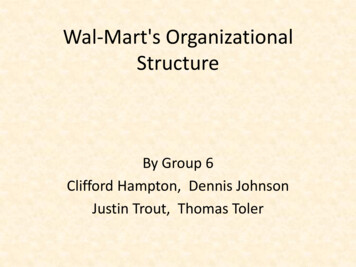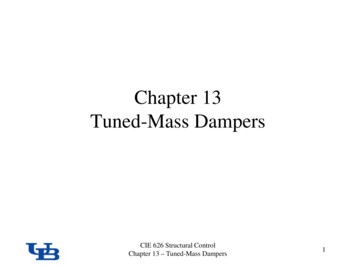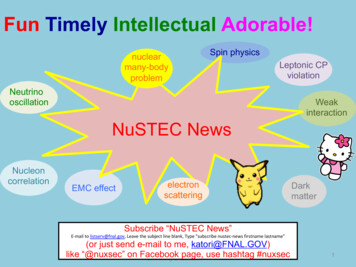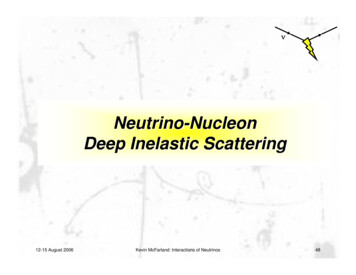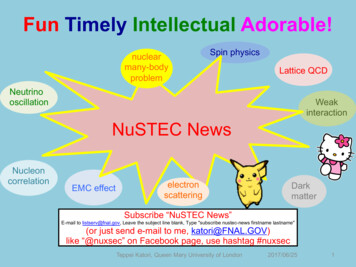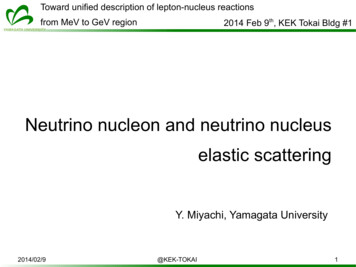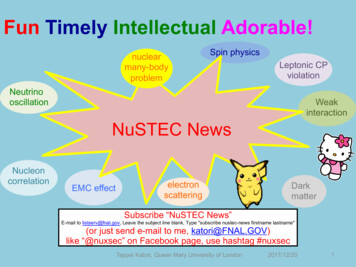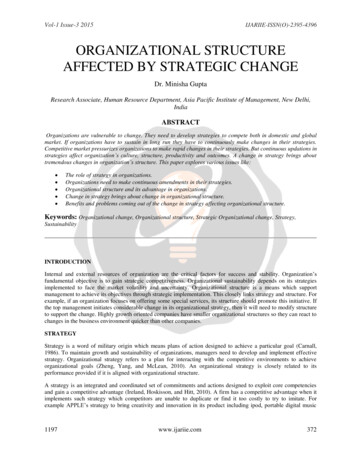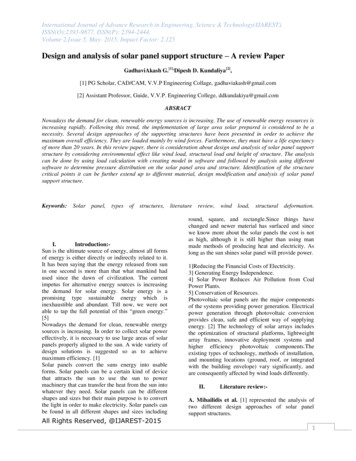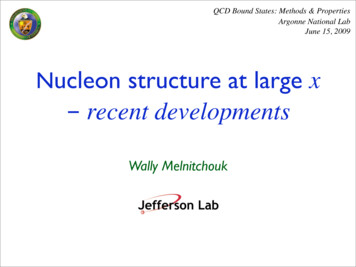
Transcription
QCD Bound States: Methods & PropertiesArgonne National LabJune 15, 2009Nucleon structure at large x- recent developmentsWally Melnitchouk
OutlineWhy is nucleon structure at large x important?d/u ratioNavigating the large-x landscapenuclear correctionstarget mass corrections & higher twistsNew global analysis (CTEQx)first foray into high-x, low-Q2 regionsurprising new results for d/uFuture experimental constraints
Quark distributionsat large x
Parton distributions functions (PDFs)provide basic information on structure of QCD bound statesextracted in global analyses of structure function datafrom electron, muon & neutrino scattering(also from Drell-Yan & W production in hadronic collisions)needed to understand backgrounds in searches fornew physics beyond the Standard Model in high-energycolliders, neutrino oscillation experiments, .DGLAP evolution feeds low x, high Q2 from high x, low Q2%" # ! 1# dq(x, t)αs (t)dyxxq(y, t) Pqgg(y, t) Pqqdt2π x yyyt log Q2 /Λ2QCD
recent PDF parameterizationvirtual “sea” ofqq pairs & gluonsat small xstructure of hadronorstructure of probe?x
Valence quarksMost direct connection between quark distributions andmodels of the nucleon is through valence quarksNucleon structure at large x dominated by valence quarks0.6uvdv!u!dx f (x,Q)0.4sg/150.2sea 0gpuudvalence00.20.40.60.81xpuud
Valence quarksAt large x, valence u and d distributions extractedfrom p and n structure functions4 uv 94nF2 dv 9pF21dv91uv9
Valence quarksAt large x, valence u and d distributions extractedfrom p and n structure functions4 uv 94nF2 dv 9pF21dv91uv9u quark distribution well determined from pd quark distribution requires n structure functiond4 F2n /F2p pnu4F2 /F2 1
2arkngValence quarksRatioof d totwistsu quark distributions particularlyHighersensitive to quark dynamics in nucleonSU(6) spin-flavor symmetry(c)(b)proton wave function p 2 1 d (uu)1 d (uu)1 33 twists2 Higher1 1 u (ud)1 u (ud)1 u (ud)0 632(a)τ 2(b)(c)diquark spininteractingqq and qgquarkcorrelationsspectatordiquark
Valence quarksRatio of d to u quark distributions particularlysensitive to quark dynamics in nucleonSU(6) spin-flavor symmetryproton wave function p 2 1 d (uu)1 d (uu)1 33 2 1 1 u (ud)1 u (ud)1 u (ud)0 632u(x) 2 d(x) for all x2F2np F23
Valence quarksscalar diquark dominanceM MN (qq)1 has larger energy than (qq)0 scalar diquark dominant in x 1 limit
Valence quarksscalar diquark dominanceM MN (qq)1 has larger energy than (qq)0 scalar diquark dominant in x 1 limitsince only u quarks couple to scalar diquarksd 0u1F2np F24Feynman 1972, Close 1973, Close/Thomas 1988
Valence quarkshard gluon exchangeat large x, helicity of struck quark helicity of hadronq ! q
Valence quarkshard gluon exchangeat large x, helicity of struck quark helicity of hadronq ! q helicity-zero diquark dominant in x 1 limit1d u53F2np F27Farrar, Jackson 1975
No FREE neutron targets(neutron half-life 12 mins)use deuteron as ‘‘effective” neutron targetBUT deuteron is a nucleus, and F2d ! F2p F2nnuclear effects (nuclear binding, Fermi motion, shadowing)obscure neutron structure informationneed to correct for “nuclear EMC effect”
22r bars show an inner bar of statistical errors, and an outer bar representing all thed systematic errors combined in quadrature.pdata were corrected for the neutron excess in iron using the ratio F2n /F2 measured(Aubert et al 1983a). The correction was negligible at small x and amounted to% at x 0.65.mpt was made to correct the iron or deuterium2 of the nucleonsNAdata for Fermi motioncleus. The effect is not expected to cancel2because of the larger Fermi momentum2but predictions for the correction (Bodek and Ritchie 1981), as shown by the solidgure 4, clearly do not explain the difference.assumed in evaluating F2 that R was zero. This was consistent with thements madeOby EMC onEMCiron (Aubert et al 1986) andThehydrogen(Aubert et alLEMC effectNuclear ‘‘EMC effect’’F (x, Q ) ! AF (x, Q2 )riginaldataater SLAC data1261etpublishedal., Phys.Lett.B 123 (1983)etalal., Phys. Rev. D 49 (1994) 4348Figure 4.AubertThe finalEMCmeasurementof the123structure function ratio (fromGomezAubert et6. Cross-section ratios compared with deuterium for SLAC data from Gomez et al (1994)(1987)), which differs slightly from the original data (Aubert et al 1983b) chiefly inFigurea normalizationchange of around 3% (reproduced with permission from Elsevier).(!) and Stein et al (1975) updated by Rock and Bosted (2001) (") for Be, Al, Fe and Au. Data
Large x landscape:nuclear effects in the deuteron
nuclear “impulse approximation’’incoherent scattering from individual nucleons in d(good approx. at x 0)AND A. W. THOMASγ54 F2d (x, Q2 ) NdIG. 1. DIS from a polarized nucleus in the impulse approximaThe nucleus, virtual nucleon, and photon momenta are denotedP, p, and q, respectively, and S stands for the nuclear spinor. The upper blob represents the truncated antisymmetriceon tensor Ĝ ! " , while the lower one corresponds to the polarnucleon-nucleus amplitude Â.#' ! p # k ' #p ' k # % . / 0 p/ 0k f 1 " p # . / ' #p ' . / # % p / f 2 "k / f 3 % " k # . / ' #k ' . / # % p / f 4 "k / f 5 %" . #' f 6 " & / 0 #' p / k 0 - 5 p” f 7 "k” f 8 %" & / 0 #' - 5 - 0 p / f 9 "k / f 10% , 13b%N p n!xdy f (y, γ) F2N (x/y, Q2 ) δ (off) F2d
nuclear “impulse approximation’’incoherent scattering from individual nucleons in d(good approx. at x 0)AND A. W. THOMASγ F2d (x, Q2 ) N!xdy f (y, γ) F2N (x/y, Q2 )nucleon momentumdistribution in ddIG. 1. DIS from a polarized nucleus in the impulse approximaThe nucleus, virtual nucleon, and photon momenta are denotedP, p, and q, respectively, and S stands for the nuclear spinor. The upper blob represents the truncated antisymmetriceon tensor Ĝ ! " , while the lower one corresponds to the polarnucleon-nucleus amplitude Â.#'N p n54(“smearing function”) δ (off) F2doff-shellcorrection( 1%)Q2 , smearing function depends also on parameteratfinite! p k #p k % . p k f " p . #p . %! p f "k f % " k . #k . % pγf "k% f q /q1 4M 2 x2 /Q20 # '/' #2//03/ 0#1/'#'/'/#'/4/#/5" . #' f 6 " & / 0 #' p / k 0 - 5 p” f 7 "k” f 8 %" & / 0 #' - 5 - 0 p / f 9 "k / f 10% , 13b%Kulagin, WM, PRC 77, 015210 (2008)
N momentum distributions in dweak binding approximation (WBA):expand amplitudes to order p! 2 /M 2!"#d3 pε γpz2f (y, γ) ψd (p) δ y 1 3(2π)M# 1!γ2 1 "2εp# 22 2 1 1 (1 3p̂z)22γyM2Mdeuteron wave function ψd (p)p" 2deuteron separation energy ε εd 2Mapproaches usual nonrelativistic momentumdistribution in γ 1 limit
N momentum distributions in dbroader withincreasing γKahn, WM, Kulagin, PRC 79, 035205 (2009)for most kinematics γ ! 2
Off-shell correctionδ (off) F2dδ (Ψ) F2dδ (off) F2d /F2dδ(p2 )F2dnegative energy components of ψdoff-shell N structure functiontotal 1 2 % effectδ(p2 )F2dδ (Ψ) F2dxWM, Schreiber, ThomasPLB 335 (1994) 11
EMC effect in deuteron#*# Frankfurt, Strikmanlight-cone model(no binding)* Kulagin, PettiNPA765 (2006)126larger EMC effect (smaller d/N ratio) at x 0.5-0.6with binding off-shell correctionscan significantly affect neutron extraction
EMC effect in deuterondeuteron wave function dependencemild dependence for x 0.8-0.85
large uncertainty fromnuclear effects in deuteron(range of nuclear models*)beyond x 0.5x* most PDFs assume no nuclear correctionssymmetry breakingmechanism remainsunknown!
Nuclear correctionsEitherExtract F2n data points from F2d , F2p data;then use data in PDF fitsnew extraction method developed which can reconstructfunctions of arbitrary shape (in DIS and resonance regions)Kahn, WM, Kulagin, PRC 79 (2009) 035205OrApply nuclear corrections to fitted PDFs;then compare with F2d datain practice choose this method
Large x landscape:target mass corrections
Target mass correctionsAdditional corrections from kinematical Q2 /ν 2 M 2 x2 /Q2 effects“target mass corrections” (TMC)Important at large x and low Q2new “Nachtmann” scaling variableξ 1 2x!1 4M 2 x2 /Q2but not unique - depends on formalism(e.g. OPE, collinear factorization)
Operator product expansionexpand product of currents in series of local operators!d4 x eiq·x !N T (J µ (x)J ν (0)) N "!"#µν µ1 µ2µµ1 ν µ2µ µ1 νµ2µµ1 νµ2 2 g q q g q q q q g g g Qk qµ3···qµ2k}22kA2k Πµ1 ···µ2kQ4klocal operators!N Oµ1 ···µ2k N "Πµ1 ···µ2k pµ1 · · · pµ2k (gµi µj terms) k!j 0( 1)j(2k j)!g···g p···pjj2 (2k)traceless, symmetricrank-2k tensorGeorgi, Politzer (1976)
n-th Cornwall-Norton moment of F2 structure functionM2n (Q2 ) !dx xn 2 F2 (x, Q2 )# "2 j!An 2j(n j)!M 2Qj!(n 2)! (n 2j)(n 2j 1)j 0take inverse Mellin transform ( tedious manipulations)F2OPE (x, Q2 )x6M x(0)2 2 3 F2 (ξ, Q ) ξ γQ2 γ 422 312M x Q4 γ 54 4where(0)F2!ξ1!ξ1(0)F2 (u, Q2 )duu2(0)F2 (v, Q2 )dv(v ξ)v2is structure function in massless (Bjorken) limit
Collinear factorizationwork directly in momentum space at partonic level(avoids need for Mellin transform)expand parton momentum k around its on-shell and2collinear component (k 0)Ellis, Furmanski, Petronzio (1983)FT,L (x, Q ) 2!"qξξ/xdy qCT,Ly# ξ 2, Q q(y, Q2 )y
Collinear factorizationwork directly in momentum space at partonic level(avoids need for Mellin transform)expand parton momentum k around its on-shell and2collinear component (k 0)Ellis, Furmanski, Petronzio (1983)FT,L (x, Q ) 2!"qξξ/xdy qCT,Ly# ξ 2, Q q(y, Q2 )yavoids unphysical x 1 region
Collinear factorizationwork directly in momentum space at partonic level(avoids need for Mellin transform)expand parton momentum k around its on-shell and2collinear component (k 0)Ellis, Furmanski, Petronzio (1983)FT,L (x, Q ) 2!"qξξ/xdy qCT,Ly# ξ 2, Q q(y, Q2 )yavoids unphysical x 1 regionat leading orderF2CF (x, Q2 )x(0) 2 F2 (ξ, Q2 )ξγξγ OPE F2 (x, Q2 )xKretzer, Reno (2004)Accardi, Qiu (2008)
Target mass correctionsprescription dependenceOPE (approx.)OPEOPE (1/Q2 )F1 (x, Q2 )(0)leading twist analysisbreaks downxHobbs, WM (2008)
F2TMC /F2Target mass correctionsCFOPECF (LO)Accardi & Qiu,JHEP 0807 (2008) 090TMC important at large x even for large Q2
Target mass corrections** JLab Hall CPsaker, WM, et al.,PRC 78 (2008) 025206TMC important for verification of quark-hadron duality
Higher twists1/Q2 expansion of structure function momentsMn (Q2 ) !(4)1dx xn 20(6)AnAn2(2)F2 (x, Q ) An 2 4 · · ·QQmatrix elements of operators withspecific “twist” ( dimension - spin)twist 2 reveals long-range q-g correlationsphenomenologically important wherever TMCs importantparametrize x dependence byF2 (x, Q ) 2F2LT (x, Q2 )!C(x)1 Q2"
New global analysis(“CTEQx”)[with Accardi, Christy,*Keppel, Monaghan, Morfin,*Owens]
Global questionsCan one obtain stable fits including low-Q 2 , low-W data?how do large-x data affect PDFs?to what extent can uncertainties be reduced?Are subleading, 1/Q2 corrections under control?how large are higher twists?How do nuclear corrections affect d/u ratio?what uncertainties do nuclear effects introduce?New analysis of proton & deuteron data includes effects of2Q /W cuts, TMCs, higher twists, nuclear corrections
Kinematic cutsBCDMSNMCSLACcut0cut2cut1JLabcut3xxcut0: Q2 4 GeV2 , W 2 12.25 GeV2cut1: Q2 3 GeV2 , W 2 8 GeV2cut2: Q2 2 GeV2 , W 2 4 GeV2cut3: Q2 m2c , W 2 3 GeV2
Data points*#factor 2 increasefrom cut0cut3######* only L-T separated data used at low Q2# new data not included in CTEQ6.1
Effect of new data on“standard” fitsextrapolation“cut0” (as in CTEQ6.1)no nuclear or1/Q 2 correctionsno significant effectin measured regionu suppression mainlydue to E866 DY data
Effect of Q2 & W cutsSystematically reduce Q 2 and W cutsFit includes TMCs (CF), HT term, nuclear corrections (WBA)WBAWBA off-shellrelative errord suppressed by 50% for x 0.5driven mostly by nuclear corrections
Effect of nuclear correctionscut3*WBAWBA off-shell* assumes F2d F2p F2nas in CTEQ6.1 and mostother global fitselative errordramatic effect of nuclear corrections:decrease in d distribution for x 0.6modest increase with (additive) off-shell correction(since EMC ratio has deeper “trough”)
Effect of nuclear correctionscut3WBArise in “free” curve appears to resultfrom enlarged data set
Effect of 1/Q2 correctionsχ2 1.6OPECF (LO)(no TMCor nuc.corr.)CF (LO)OPEχ2 11/Q2 HT coefficient parametrized as C(x) c1 xc2 (1 c3 x)important interplay between TMCs and higher twist:HT alone cannot accommodate full Q2 dependencestable leading twist when both TMCs and HTs included
Deuteron / proton ratioConsistency check of fit with F2d /F2p ratio (not used in fit)fits without nuclear corrections overestimate dataat intermediate x, do not reproduce rise at large x
d/u PDF ratiofull fits favorssmaller d/u ratiodominance ofnonperturbativephysics?relative u error(x10)relative d error(x10)reduced errorswith weaker cuts
Future constraintsfrom experiment
“Cleaner” methods of determining d/usemi-inclusive DIS from dtag “spectator” protonse d e pspec X33e He( H) e X3 He-tritiume p e π Xsemi-inclusive DIS as flavor tag e p ν(ν̄)X ν(ν̄) p l X p p(p̄) W X!eL (!eR ) p e X}mirror nucleiweak current as flavor probedifficult to get highrates/luminosities
3He-3H mirror nucleiEMC ratios for A 3 mirror nuclei3HeF23R( He) p2F2 F2n3HFR(3 H) p 2 nF2 2F2Extract n/p ratio from measured 3He-3H ratioF2npF23He32R F2 /F2 H 3 He3H2F2 /F2 RR(3 He)R R(3 H)
3He-3H mirror nucleiR (3He) / R (3H)1.02PEST CSBPEST1.011density0.9900.20.40.60.81Afnan et al.,PRC 68 (2003) 035201xnuclear effects cancel to 1% level
3He-3H mirror nuclei
Spectator protonW 2 taggingM 2 2M" # Q2ed epXr (M D "E S ," p S ) ; # n 2 " # S!target drrecoilpE S # p S qˆrE S , pS ) ; "S M D /2slow backward pneutron nearly22W ( p n q) p nµr rp n µ 2((M D " E s )# " p n q) " Q% M * 2 2M# (2 " & S ) " Q 222QQJLabHall B experiment (‘‘BONUS’’)on-shellx* "# (2 completed % S )2 p n µ qµ 2MrunDec. 2005minimize!rescattering
Spectator protonW 2 taggingM 2 2M" # Q2ed epXr (M D "E S ," p S ) ; # n 2 " # S!target drrecoilpE # p S qˆrE S , pS ) ; "S SM D /2slow backward pneutron nearlysemi-inclusivecross sectioninclusive cross sectionr r2µ2W ( p n q) p n p n µ 2((M D " E s )# " p n q) " Q% M * 2 2M# (2 " & S ) " Q 2morepronounced neutron22QQresonance structure visible*on-shellx "µ2 p n qµ 2M# (2 % S )minimize!rescattering
Spectator protonW 2 taggingM 2 2M" # Q2ed epXr (M D "E S ," p S ) ; # n 2 " # S!target dYRANIMILErrecoilpE S # p S qˆrE S , pS ) ; "S M D /222W ( p n q) p nRPµr rp n µ 2((M D " E s )# " p n q) " Q% M * 2 2M# (2 " & S ) " Q 2slow backward pfirst“proof of principle” data22QQneutron nearly on-shellx* "µ % S ) to x 0.85 after2 p n qµ 2M# (2extendminimize!rescattering12 GeV Upgrade
Summary & OutlookNew global PDF analysis (CTEQx) including high-x, low-Q2 dataStable leading twist PDFs obtained with TMC, higher twistand nuclear correctionsopens door to study of quark structure of nucleonover large kinematic domainreadily accommodate new data (e.g. BONUS)Results suggest small d/u ratio up to x 0.85
Summary & OutlookNew global PDF analysis (CTEQx) including high-x, low-Q2 dataStable leading twist PDFs obtained with TMC, higher twistand nuclear correctionsopens door to study of quark structure of nucleonover large kinematic domainreadily accommodate new data (e.g. BONUS)Results suggest small d/u ratio up to x 0.85Additional effects to consider: large-x resummation (pQCD),jet mass corrections, quark-hadron duality (reduce cuts further)Extend analysis to spin-dependent PDFs
The End
an ‘EMC ratio’ somewhat below unity for x 0.1 (in contradiction with the original EMC result of Aubert et al (1983b)), a rise above unity for 0.1 x 0.3 and a steady fall beyond. The data are at considerably lower Q2 than EMC, and any differences co
